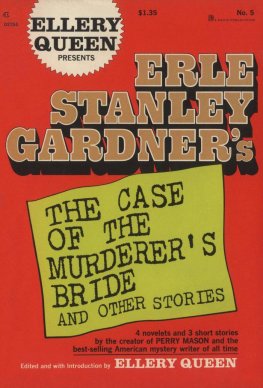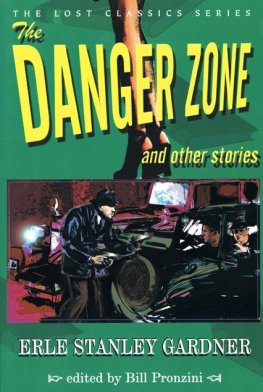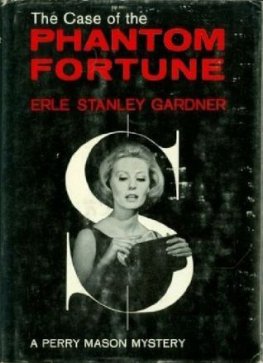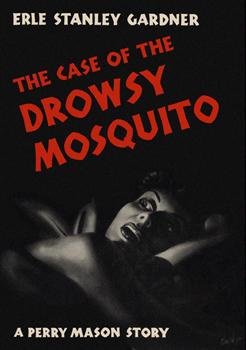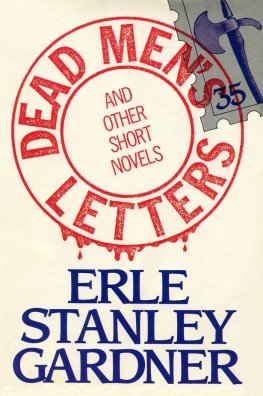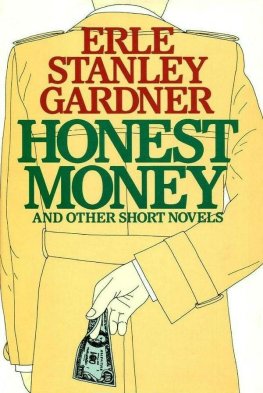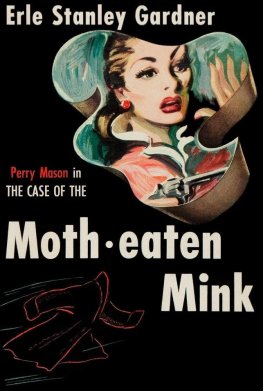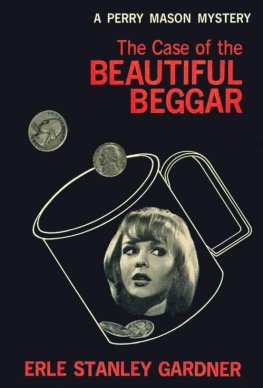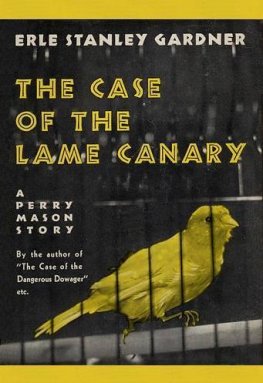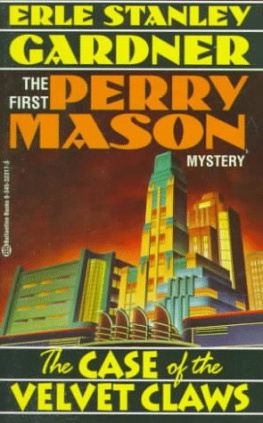Erle Stanley Gardner
The Case of the Murderers Bride and Other Stories
The Case of the Murderers Bride, 1957 by Erle Stanley Gardner.
Only by Running (Flight into Disaster), copyright 1952 by Erle Stanley Gardner.
The Candy Kid, copyright 1931 by Red Star News Co., copyright renewed by Erle Stanley Gardner.
To Strike a Match (The House of Three Candles), copyright 1938 by Erle Stanley Gardner, renewed.
Death Rides a Boxcar, copyright 1944 by Erle Stanley Gardner, renewed.
Danger out of the Past (Protection), copyright 1955 by Erle Stanley Gardner.
The Jeweled Butterfly, copyright 1952 by Erle Stanley Gardner.
Novelets
Corporal Cortland and Dr. Dixon in
The Case of the Murderers Bride
Lester Leith versus Sergeant Ackley in
The Candy Kid
Jayson Burr and Gabby Hilman in
Death Rides a Boxcar
Peggy Castle and Uncle Benedict in
The Jeweled Butterfly
Short Stories
Only by Running (Flight into Disaster)
To Strike a Match (The House of Three Candles)
Dancer out of the Past (Protection)
An Unorthodox Introduction[biographical data]
Name: Erie Stanley Gardner. Born in Malden, Massachusetts, on July 17, 1889. Admitted to the California bar in 1911. Died on March 11, 1970. After the death of his first wife, married on August 7, 1968, to the woman who had been his Executive Secretary for many years Jean Bethell. One child by his first marriage, Grace Naso.
[publishing history]
Erie Stanley Gardners first magazine story, The Police of the House, was published in 1921. His first book was a Perry Mason novel, The Case of the Velvet Claws, published in 1933. [As of 1970, thirty-seven years after Velvet Claws, Mr. Gardner had written 143 books, of which 82 are Perry Mason titles and 15 are nonfiction. | No other author in the United States has equaled his total sales. The last compilation gave sales in the United States and Canada alone as approximately 200,000,000 copies.
[working day, early in career]
He always had vivid recollections of putting in day after day trying a case in front of a jury, which is one of the most exhausting activities, then dashing up to the law library after court had adjourned to spend three or four hours looking up law points with which | Perry Mason-like] he could trip his adversary the next day, then going home, grabbing a glass of milk with an egg in it, dashing upstairs to his study, ripping the cover off his typewriter, noticing it was 11:30 p.m., and settling down with grim determination to get a plot for a story. Along about 3:00 in the morning he would have completed his daily stint of a 4000-word minimum and would crawl into bed, only to wake up about 6:00 with a new idea which he would transmit to the typewriter, then grab a hurried breakfast, shave and be on his way to the office where hed rush through correspondence and dictation so he could beat it up to the courthouse and be on hand to smile at the jury promptly at 10:00... During nearly all this time he had a schedule of having a novelette in the mail every third day, a schedule which he rigorously maintained.
[looking back on early-career working day]
Why the heck does a guy live like that? Mr. Gardner didnt know. He certainly didnt do it for money. About half of his law practice was given away, fighting for people who didnt have any money but whose rights had been infringed... When he came right down to it, Mr. Gardner guessed it was just an inherent desire to accomplish a lot, realizing that life was going to be too short to do it.
[some personal characteristics]
He couldnt stand petty squabbles. He hated paper work. He didnt have the time to bicker about details. He went in for adventure, horseback riding, travel, and photography.
[sources of material; opinions; modus operandi]
He drew on his wealth of experience in the solution of crime. He also had 25 years of experience as a practicing trial lawyer.
He believed that readers like mystery stories because the story presents a problem which absorbs the attention of the reader and then brings that problem to a logical and final solution. Most readers are beset with a lot of problems they cant solve. When they try to relax, their minds keep gnawing over these problems and there is no solution. They pick up a mystery story, become completely absorbed in the problem, see the problem worked out to a final and just conclusion, turn out the light and go to sleep.
Few writers, he believed, analyze their methods of working out plots. He always did. To begin with, every story plot must have the lowest common denominator of public interest the Cinderella basis, for example, used so often in Hollywood... Mr. Gardner had quite a list of basic plots, but they were his secret let the other boys figure out their own.
He thought modern detective stories far ahead of the earlier stories, so far as technique was concerned.
How long did it take him to write a novel? Thirty years ago he dictated a book in a week or ten days, revised and polished it and got it into the hands of the publisher within two or three weeks of the time he started. Later he revised and re-revised, and did so much reading that whenever he got a chance to relax he threw a saddle on a horse, picked up a gun or a bow and arrow, or climbed in a car and went tearing out in search of new material and adventure.
[number of series characters]
He always had a yen for series characters, but he didnt know how many he created. For some ten years prior to the publication of his first book, he wrote over 1,000,000 words a year which were sold to magazines. Back in the old wood-pulp days there was Senor Amaz de Lobo, professional soldier of fortune and revolutionist; Jax Bowman (he couldnt remember anything about him!); Sidney Zoom and his police dog; the Patent Leather Kid, a suave, sinister chap; the firm of Small, Weston & Burke; Ed Jenkins, the Phantom Crook, a lone wolf type who ran in magazines for something over 20 years; Whispering Sands; Speed Dash, a human fly who developed a photographic memory Mr. Gardners first series character; Major Brane, free-lance secret service man; El Paisano, who could see in the dark; Larkin, a juggler who carried no other weapon than a billiard cue; Black Barr, a typical Western two-gun guy, who felt he was an instrument of divine justice; Hard Rock Hogan; Fong Dei; Crowder, Rapp; Skarle... | to say nothing of D.A. Douglas Selby; Bertha Cool and Donald Lam; Gramps Wiggins; Sheriff Bill Eldon; Terry Clane; Lester Leith; and, of course, the one and only Perry Mason).
[number of pen names]
A. A. Fair, Charles M. Green |his first |, Kyle Coming, Grant Holiday, Robert Parr, Carleton Kendrake, Charles J. Kenny, Arthur Mann Sellers, Les Tillray, Dane Rigley, Charles M. Stanton.
[the man behind the writer]
For many years he investigated cases of innocent persons who had been wrongfully convicted, and, as a leading member of the so-called Court of Last Resort, he and several associates donated their time and at their own expense brought about ultimate justice in dozens of cases.
An Unorthodox PostscriptDear Reader:
Now, just what is unorthodox about the preceding Introduction? Its form or arrangement? Yes. The impression that its components are somewhat disjointed, perhaps lacking in the smooth flow usually found in an editorial foreword? Yes. But there is something else something far more unorthodox.
You had every right to assume that the Introduction you have just read was written by Ellery Queen. The front cover, the title page, the contents page all said so. Well, it is true that Ellery Queen wrote the longhand notes for the Introduction, organized the sequence of the notes, typed the first draft and the final copy, sent the text to the press for typesetting, proofread the galleys, and later the page proofs hut Ellery Queen did not

